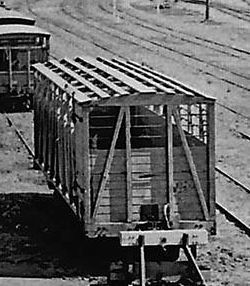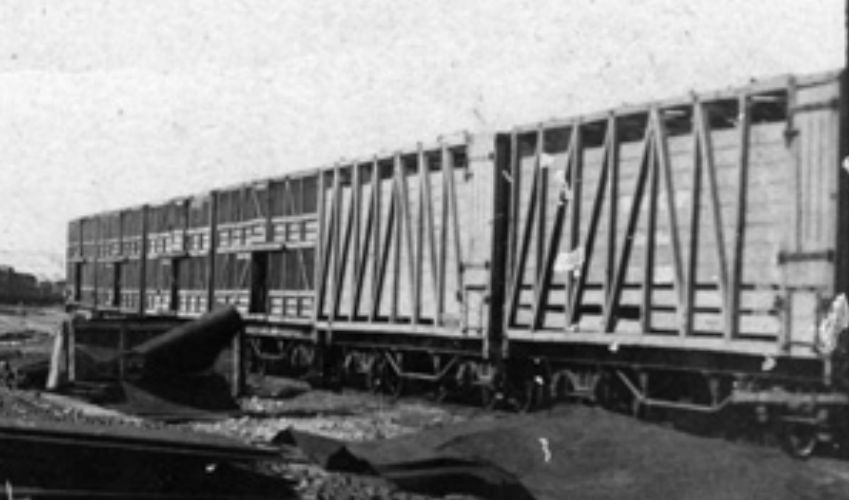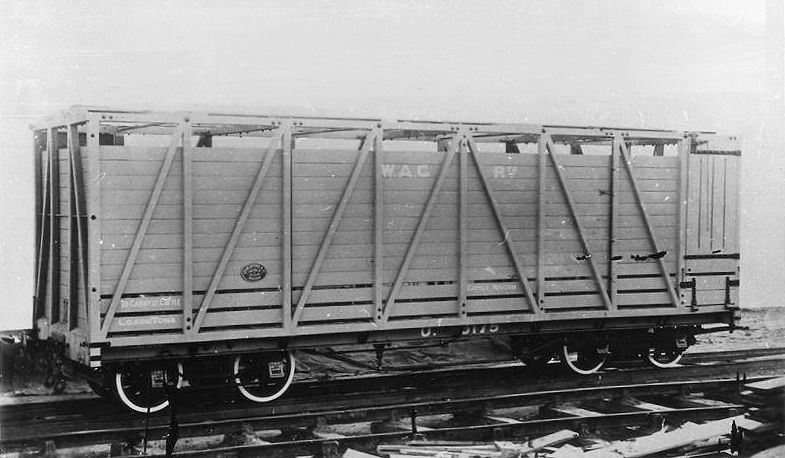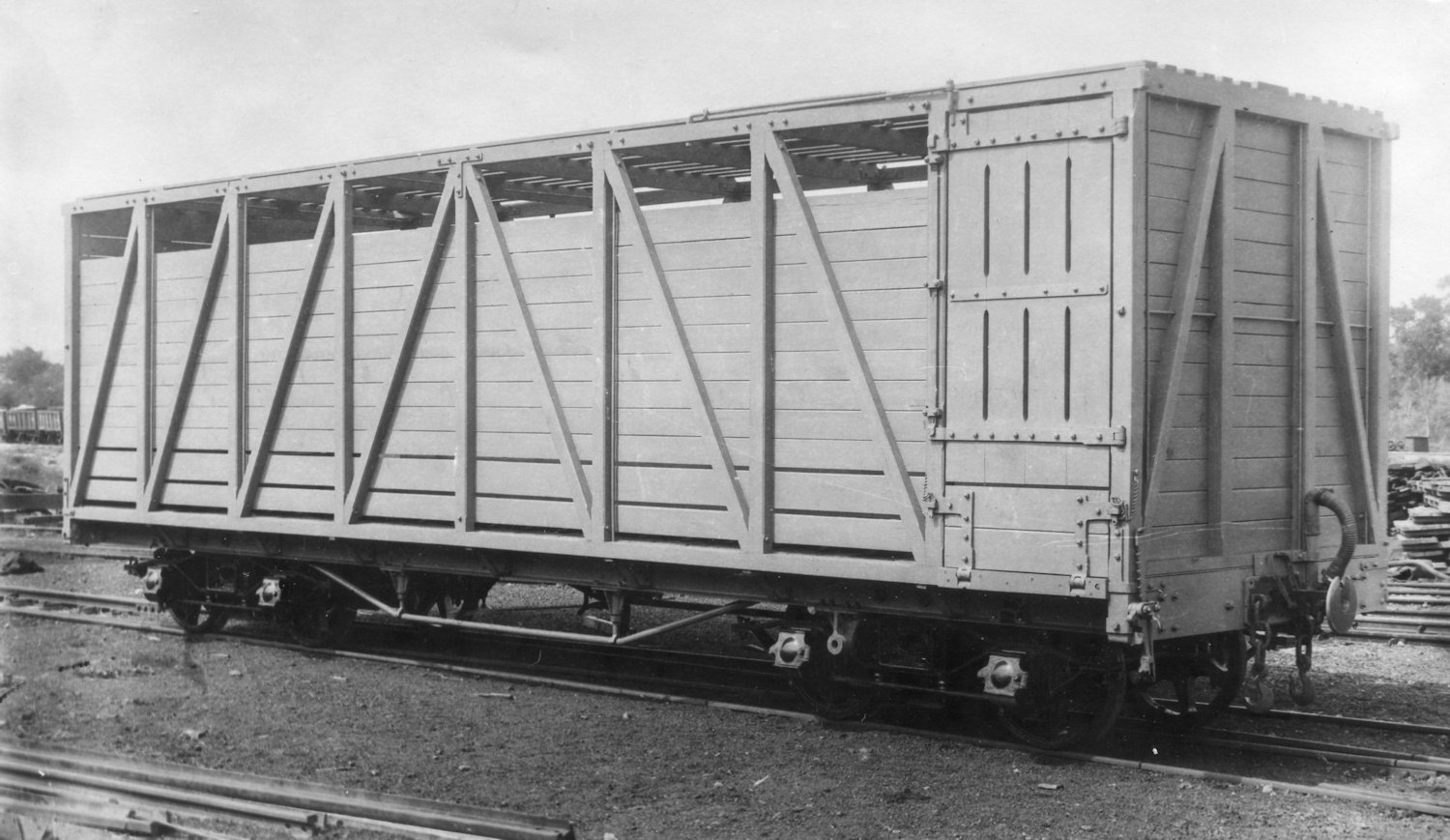| T Class Bogie cattle trucks (Class OB before 1900) |
 | |||||||||
|
The photo above, blown up from State Library of LWA 017550PD, illustrates the problem with the T class. Even though there were only 90 of them in total, they came in a variety of shapes on the same 30' length chassis. The T class bogie cattle trucks were amongst the very first bogie vehicles ordered for the W.A.G.R. The first batch of twelve wagons (534 - 545) was built in 1893. The sides and ends of this first batch, originally at least, appear to have been more open than on the later vehicles and they also had rounded tops to the ends. I believe it is one of these wagons that is shown in the early photo at right which is enlarged from an image in the State Library of WA collection BA1344/73. They were long lived vehicles and were written off as follows:
Further batches arrived in 1897-8 but these all seem to have had differences - at least what photos I have seen show what appear to be different configurations and this is confirmed to some extent by the outline diagrams. Unfortunately I haven't yet seen any photos clear enough to read the numbers. |
 | ||||||||
|
The next batch were 2085-2120 in 1897, Amongst this group were 26 wagons which were fitted with bogies which had four brake shoes rather than the normal two. These are believed to have been 2085 - 2110 built in 1896. Most went in 1954/5 when they were largely displaced by the 90 new TA class wagons coming in to service. Amazingly, but not untypically for the W.A.G.R. some lasted longer as cattle wagons than those TA which were converted in the late fifties and early sixties into other classes. The early withdrawals were presumably accident victims. |
| 189? | 2095 for some reason either renumbered to or replaced by 4923. In the 1900 renumbering list 2095 is missing and 4923 was a blank number at the end of the list which had not yet been issued. It is possible that the wagon was sold and then repurchased. |
| 1948 | 2105 written off |
| 1950 | 2118 written off |
| 1951 | 4923 written off |
| 1953 | 2096, 2120 written off |
| 1954 | 2085, 2086, 2091, 2092, 2094, 2097, 2098, 2101-2104, 2106, 2109, 2110, 2111, 2114-2116 written off |
| 1955 | 2088, 2089, 2090, 2093, 2099, 2100, 2107, 2108, 2112, 2117, 2119 written off |
| 1957 | 2113 written off |
| 1962 | 2087 written off |
|
The photo at right, enlarged from State Library of WA collection photo 013518D, shows two T class wagons at the right of the image. The one furthest right is similar to the builders photo below of OB3175 but has fewer planks in the side (10 vs 12). These two wagons could be from either the 2085-2120 groups or the next batch of twelve wagons(3013-3024) which arrived in 1897. |
 |
|
The 3015-3024 group were written off as follows: | |
| 1946 | 3023 written off |
| 1954 | 3014, 3016, 3018, 3019, 3022, 3024 written off |
| 1955 | 3013, 3017, 3020, 3021, written off |
| 1957 | 3015 written off |
| The penultimate batch of twenty-five wagons were 3175-3199 which arrived in 1898. At least with this group we have a builder's photo. T3180 must have been an accident victim to be written off in 1920. | |
| 1920 | 3180 written off |
| 1946 | 3194, 3197 written off |
| 1953 | 3183 written off |
| 1954 | 3176-3178, 3181, 3185, 3187, 3189, 3192, 3193, 3198, 6791 written off |
| 1955 | 3175, 3182, 3184, 3190, 3196 written off |
| 1956 | 3191 written off |
| 1959 | 3186 to JETTY 263 |
| 1963 | 3188 to JETTY 190 |
| 1966 | 3195, 3199 to JETTY 321, 322 |
| 1967 | 3179 written off |
|
Builders photo of OB3175 from the RHWA collection. | |
| The final batch of five wagons were 6791- 6795 built at Midland Workshops in 1906. | |
| 1954 | 6791 written off
6793 to JETTY 10 |
| 1955 | 6792, 6794 written off |
| 1957 | 6795 to JETTY 192 |
|
WAGR official photo. (RHWA collection) Although this wagon isn't lettered I think that it is probably one of the final batch. Why? The slats on the roof match the contemporary WAGR built B and BD type cattle wagons as do the ends with boarding all the way to the roof. Also the handbrake handle hasn't been fitted yet so it must be brand new. The number of planks in the side is different again (11). What I don't know is if any of the earlier wagons were rebodied to this standard in later years - it is quite possible. |
|
Whilst there are outline diagrams for class T they aren't necessarily a great deal of help! Firstly there is this one. It claims to cover 3 groups of wagons. 12 with a curved roof, 10 with a flat roof and vacuum brakes and 37 other flat roofed wagons. The curved roof ones are obviously the first group (534-545). The 37 wagons are probably 3015-3024 and 3175-3199 leaving the remaining ten from this diagram as part of the 2085-2120 group.
|
|
Secondly there is this one which applies to a group of 26 wagons, these are probably the rest of the 2085-2120 group. There is a problem with this diagram. It shows this group as 9'-7" high whereas the ones on the earlier diagram are a foot taller. We know from photos that some of the wagons were indeed shorter than others so this rings true but the diagram as drawn scales out at the same height as the first diagram and in this it is clearly in error. The planking also doesn't seem to match the known photos either. Both of these diagrams were issued before the final batch of wagons was built.
|
| Other Cattle trucks
The W.A.G.R.'s other cattle trucks were classes B, BD, BE, and BS, and the newer bogie vehicles in Class TA. |



